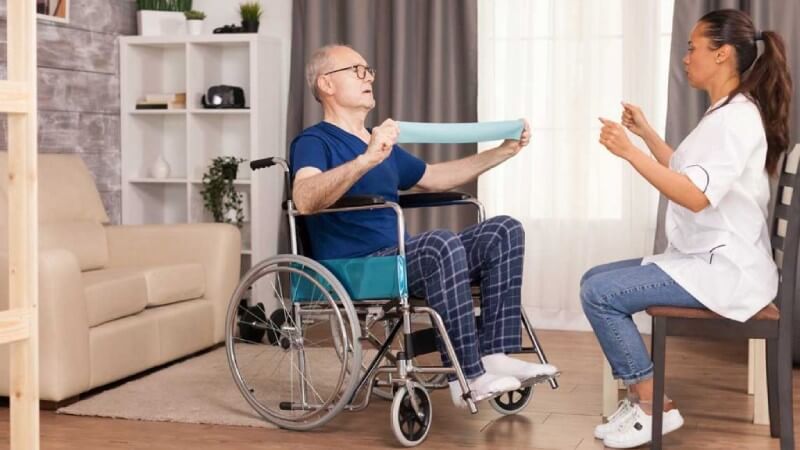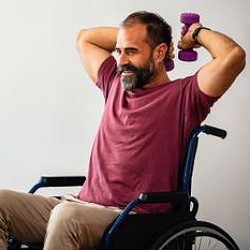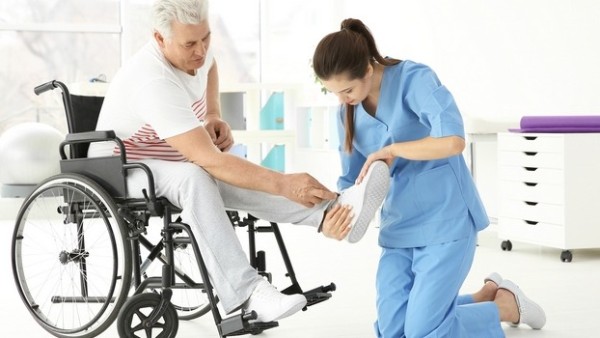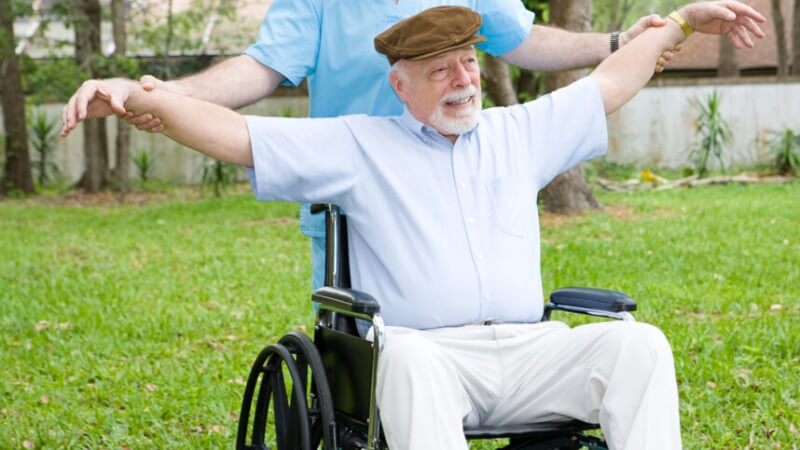Discover Fun Exercises for Seniors in Wheelchairs: Boosting Health & Spirits!
Exercise is not just a luxury; it’s a necessity, especially for seniors in wheelchairs. While mobility challenges can make traditional exercises difficult, it’s crucial to understand that staying active can significantly enhance the quality of life.
Engaging in regular physical activity can help in maintaining muscle strength, improving circulation, and boosting mental well-being.

Challenges Faced by Seniors in Wheelchairs
Seniors in wheelchairs often face a unique set of challenges when it comes to staying active:
- Physical Barriers: Traditional exercise equipment or routines might not be wheelchair-friendly.
- Limited Options: A lack of knowledge about wheelchair-specific exercises can lead to limited exercise options.
- Health Concerns: Some seniors might have health issues that make certain exercises risky.
Benefits of Strength Training for Wheelchair Users
Strength training, in particular, offers a plethora of benefits for seniors in wheelchairs:

- Muscle Maintenance: Helps in preserving muscle mass, which tends to decrease with age.
- Bone Health: Strength training can aid in increasing bone density, reducing the risk of fractures.
- Mental Boost: Regular exercise releases endorphins, the body’s natural mood elevators, promoting a sense of well-being.
Engaging in exercises tailored for wheelchair users can not only enhance physical health but also provide a sense of accomplishment and independence. It’s all about finding the right balance and understanding that every movement counts!
Upper Body Exercises

Strengthening the upper body is crucial for seniors in wheelchairs to maintain mobility, independence, and overall health. Let’s dive into some effective exercises tailored for them:
Shoulder Retractions for Beginners
Shoulder retractions are a fantastic starting point for those new to upper body exercises. They help in improving posture and shoulder stability.
- Description and Steps:
- Sit upright in your wheelchair.
- Keep your arms relaxed by your sides.
- Slowly pull your shoulders back, squeezing the shoulder blades together.
- Hold for a few seconds and then release.
- Repeat for the desired number of repetitions.
- Variation with Resistance Band:
- Hold a resistance band with both hands in front of you.
- Pull the band apart by moving your hands away from each other, retracting the shoulders.
- Slowly return to the starting position and repeat.
Chest Squeeze
The chest squeeze exercise targets the chest muscles and also engages the arms.
- With a Medicine Ball:
- Hold a medicine ball with both hands in front of your chest.
- Squeeze the ball as hard as you can, feeling the chest muscles contract.
- Release and repeat.
- Without a Medicine Ball:
- Clasp your hands together in front of your chest.
- Push your palms together, squeezing the chest.
- Release and repeat.
Chest Press with Resistance Band
This exercise is excellent for strengthening the chest, shoulders, and triceps.
- Description and Steps:
- Secure a resistance band behind your wheelchair or any sturdy object.
- Hold the ends of the band with both hands.
- Push your hands forward, extending your arms fully.
- Slowly return to the starting position and repeat.
- Importance of Controlled Movement:
- Ensure that you move in a controlled manner to maximize muscle engagement and prevent any strain or injury. Avoid jerky or rapid movements.
Remember, consistency is key! Incorporating these exercises into your routine can significantly improve upper body strength and overall well-being.
Leg Strengthening Exercises
While wheelchair-bound seniors might face challenges in leg mobility, it’s essential to understand that leg exercises can still be beneficial. Engaging in leg exercises can help maintain muscle tone, improve blood circulation, and boost overall well-being.
Let’s explore some effective leg exercises tailored for seniors in wheelchairs:

Toe Taps
Toe taps are a simple yet effective exercise to activate the muscles in the feet and lower legs.
- Basic Toe Taps:
- Sit upright in the wheelchair with feet flat on the ground.
- Lift the toes while keeping the heels on the ground.
- Lower the toes back down.
- Repeat for the desired number of repetitions.
- Variation with Leg Raised:
- Raise one leg slightly off the ground.
- Perform the toe tap motion with the raised foot.
- Alternate between both feet.
Knee Lifts
Knee lifts target the quadriceps and hip flexors, enhancing leg strength and flexibility.
- Description and Steps:
- Sit upright in the wheelchair.
- Hold onto the sides of the wheelchair for support.
- Slowly lift one knee towards the chest.
- Lower it back down gently.
- Alternate between both legs and repeat.
- Variation with Pause for Increased Intensity:
- As you lift the knee, hold the position for a few seconds before lowering.
- This pause adds intensity and engages the muscles more deeply.
Remember, every movement counts! Even if the range of motion is limited, the effort put into these exercises can lead to improved muscle strength, better circulation, and enhanced mood.
Core and Abs Strengthening
A strong core is the foundation of a healthy body, even for seniors in wheelchairs. Engaging the core muscles not only improves posture and balance but also aids in daily activities, making movements smoother and more efficient. Let’s dive into some core-strengthening exercises that are both effective and wheelchair-friendly:

Tummy Twist
The Tummy Twist is a fantastic exercise to engage the oblique muscles and enhance rotational mobility.
- Description and Steps:
- Sit upright in the wheelchair with feet flat on the ground.
- Hold a lightweight object, like a water bottle, with both hands in front of you.
- Slowly rotate the torso to one side, bringing the object towards that side.
- Return to the center and repeat on the other side.
- Importance of Maintaining Lower Body Stillness:
- Keeping the lower body still ensures that the twist targets the core muscles effectively.
- It also prevents any strain on the lower back.
Captain’s Chair
This exercise mimics the movement of leg raises, focusing on the lower abdominal muscles.
- Description and Steps:
- Sit at the edge of the wheelchair seat.
- Hold onto the armrests or sides of the wheelchair for support.
- Lift both legs together, keeping them straight, and then lower them down.
- Precautions to Take:
- Ensure the back is straight throughout the exercise.
- Avoid jerky movements to prevent any strain.
The Side Bend Stretch
This stretch targets the obliques and enhances flexibility along the sides of the torso.
- Description and Steps:
- Sit upright in the wheelchair.
- Extend one arm overhead while bending the torso to the opposite side.
- Return to the center and repeat on the other side.
- Variation for Increased Intensity:
- Hold a lightweight object in the extended hand while performing the bend.
Strengthening the core is not just about aesthetics; it’s about enhancing the quality of life. With a robust core, daily activities become more manageable, and the risk of injuries diminishes. So, let’s get twisting, bending, and stretching!
Benefits of Exercise for Wheelchair Users
Exercise is not just a privilege for those who can walk or run; it’s a right and a necessity for everyone, including wheelchair users. The benefits of regular exercise for wheelchair users are manifold, touching various aspects of physical health, mental well-being, and daily life functionality. Let’s delve into these benefits:
Physical Benefits

- Muscle Strength: Regular exercise helps in strengthening the muscles, which is crucial for wheelchair users to maintain their mobility and perform daily tasks with ease.
- Stamina: Over time, consistent exercise can increase endurance, allowing wheelchair users to be active for longer periods without feeling fatigued.
- Improved Blood Flow: Exercise promotes better circulation, ensuring that every part of the body receives adequate oxygen and nutrients.
- Reduced Risk of Diseases: Engaging in regular physical activity can decrease the risk of cardiovascular diseases, diabetes, and other health issues.
Mental Benefits

- Reduced Anxiety: Physical activity releases endorphins, the body’s natural stress-relievers, helping to reduce anxiety levels.
- Improved Mood: Exercise can act as a mood enhancer, warding off feelings of depression and promoting a sense of well-being.
- Increased Self-confidence: Achieving fitness goals and improving physical health can boost self-esteem and confidence.
Daily Life Improvements

- Reduced Risk of Pressure Sores: Regular movement and changing positions can help prevent the formation of pressure sores, a common concern among those who remain seated for extended periods.
- Prevention of UTIs: Physical activity can aid in preventing urinary tract infections by promoting better bladder health.
- Improved Mobility: Strengthened muscles and increased stamina can lead to enhanced mobility, making it easier for wheelchair users to move around and engage in various activities.
Incorporating exercise into one’s routine can be transformative, especially for wheelchair users. It’s not just about physical health; it’s about enhancing the quality of life, fostering independence, and promoting overall well-being.
Tips for Safe Exercise
Embarking on an exercise journey, especially for seniors in wheelchairs, is both exciting and beneficial. However, safety should always be at the forefront.

After all, the goal is to enhance well-being, not to invite unnecessary risks. Here are some essential tips to ensure that your exercise routine is both effective and safe:
Consulting with a Doctor
- Before diving into any new exercise regimen, it’s paramount to consult with a healthcare professional. They can provide guidance tailored to your specific health conditions and needs, ensuring that you’re on the right track.
Starting Slowly
- Rome wasn’t built in a day, and neither is physical fitness. Start with short exercise sessions and gradually increase the duration and intensity. This approach helps in preventing injuries and ensures that the body has ample time to adapt.
Maintaining Good Posture
- Posture is key when it comes to exercising. Proper alignment ensures that the right muscles are targeted and reduces the risk of strains. Whether you’re stretching or strength training, always be mindful of keeping a straight back and aligned shoulders.
Rest and Recovery
- While it’s tempting to push through and exercise daily, it’s vital to incorporate rest days, especially after strength training sessions. Muscles grow and repair during these rest periods, leading to increased strength and reduced risk of injury.
Safety and effectiveness go hand in hand when it comes to exercise. By following these tips, you can ensure that your fitness journey is not only rewarding but also free from unnecessary setbacks. Remember, it’s not about how fast you reach your goals, but how sustainably you achieve them.
FAQs
Navigating the world of exercise for seniors in wheelchairs can come with a plethora of questions. Let’s address some of the most frequently asked ones to provide clarity and guidance:
Why is exercise important for seniors in wheelchairs?
Exercise is paramount for seniors in wheelchairs as it offers a myriad of benefits. Regular physical activity helps in maintaining muscle strength, improving circulation, and boosting mental well-being. It also plays a crucial role in enhancing the quality of life, fostering independence, and promoting overall well-being.
How often should these exercises be performed?
The frequency of exercises depends on individual goals and health conditions. However, a general recommendation is to engage in moderate aerobic activity for at least 150 minutes a week. Strength training exercises can be done on alternate days, allowing muscles to recover in between.
Can these exercises be done without any equipment?
Absolutely! Many exercises tailored for wheelchair users can be performed using just body weight. For instance, toe taps, knee lifts, and certain stretches don’t require any equipment. However, incorporating resistance bands or lightweight objects can add variety and intensity to the routine.
What precautions should be taken while exercising?
Safety first! Before starting any new exercise regimen, it’s essential to consult with a healthcare professional. Always maintain proper posture during exercises to prevent strains. Start slowly, gradually increasing the intensity, and ensure to incorporate rest days for muscle recovery.
Exercise is a journey, not a destination. By addressing these common queries, we hope to make the path smoother and more rewarding for seniors in wheelchairs.
